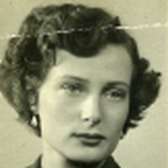
-
Learn More about Estelle
- Collections View Estelle's papers and photographs
- Echoes of Memory Read Estelle's writing
- First Person Watch Estelle share her Holocaust experiences at a First Person program
- Oral History Access Estelle's Oral Testimony
Estelle Wakszlak Laughlin was born in Warsaw, Poland, on July 9, 1929 to Michla and Samek Wakszlak. Estelle also had an older sister, Freda, who was born in January 1928. Michla tended to the home and children while Samek ran a jewelry shop. Estelle and Freda attended the local public school.
Germany invaded Poland on September 1, 1939. The siege on Warsaw began a week after German forces invaded Poland. On September 27, a ceasefire was called, and soon after, German forces entered Warsaw. Estelle and Freda were no longer able to attend the local public school. In October 1940 German forces decreed the establishment of a ghetto. The Wakszlak family and more than 400,000 Jews from the city and surrounding areas were forced to live in a 1.3 square mile area and to wear a white armband with a blue Star of David. The food allotments rationed to the ghetto by the German authorities were not sufficient to sustain life; however, Samek was able to get extra food for his family from the black market. From July to September 1942, more than 260,000 ghetto residents were deported to the Treblinka killing center. During this time Estelle and her family hid in a secret room to escape the deportations.
In April 1943 German forces made one last push to deport the remaining 55,000-60,000 Jews from the Warsaw ghetto to forced labor sites or killing centers. Samek, who helped to organize the resistance movement, built a bunker in which he and his family could hide during the Warsaw ghetto uprising. As SS and police units began roundups, resistance fighters met them with artillery fire from resistance fighters. In retaliation, the SS began razing the ghetto, block by block. The bunker where Estelle and her family were hiding, which was in the basement of a house, was exposed by a bomb. The Germans dragged the Wakszlak family out onto the street, marched them to a central gathering point, forced them to board freight train cars, and transported them to the Lublin-Majdanek concentration camp.
Upon arrival at Majdanek, the SS separated the women and men. Estelle, Michla, and Freda were chosen for forced labor but Samek was murdered in the gas chamber. The women moved soil from one place outside the camp to another. At one point Freda was badly beaten by a German guard and could not work. She hid in the barracks, but was discovered. The Germans put her name on what she suspected was a gas chamber list. To stay together, even if it meant they would die, Estelle and Michla switched places with two women who were on the same list. Michla, Estelle, and Freda were, instead, sent to the Skarżysko concentration camp to work in a munitions factory, and were later transferred to another weapons factory at the Czestochowa concentration camp.
Soviet forces liberated Czestochowa in January of 1945. To escape pogroms in Poland the three women moved to Allied-occupied Germany in August 1945 and lived there until 1947, when they moved to the United States to join Michla’s two sisters and brother in New York City. Estelle is a volunteer at the United States Holocaust Memorial Museum.
